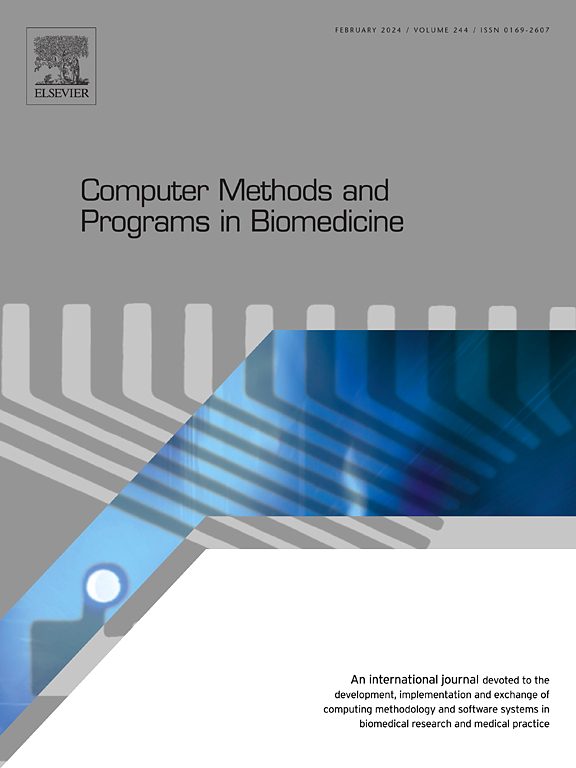Differentiating characteristics of EMG signals in pediatric muscle tone disorders in the aspect of evaluating postural control
IF 4.8
2区 医学
Q1 COMPUTER SCIENCE, INTERDISCIPLINARY APPLICATIONS
引用次数: 0
Abstract
Background and Objective:
Abnormalities in muscle tone, such as postural hypotonia, can significantly affect motor development and postural control in children, often presenting with unclear origins and subtle clinical manifestations. These disturbances may also be associated with broader musculoskeletal dysfunctions. The presented research aims to examine whether electromyographic signal analysis can support the objective evaluation of muscle tone abnormalities in children.
Methods:
Electromyography (EMG) signals were recorded from the sternocleidomastoid and rectus abdominis muscles during the Neck Flexor Endurance Test in 31 children. Time-domain and frequency-domain characteristics were analyzed using statistical methods to differentiate groups classified by physiotherapy experts. Machine learning methods were used to objectively verify the usefulness of the collected data in classification tasks. Statistical analysis included group comparison using Student’s t-test or non-parametric Mann–Whitney U test, where applicable.
Results:
Compensatory mechanisms were observed in children with reduced muscle tone, with increased activation of the rectus abdominis muscles. EMG analysis revealed that the rectus abdominis muscles exhibited 25 statistically important features. Feature selection methods like RefielF presented the most differentiating set from sternocleidomastoid muscles (20 features). The Support Vector Machine showed the best overall performance (78.8%) with mean value data set.
Conclusions:
The EMG signal analysis revealed significant differences between children with reduced muscle tone and those with normal tone, emphasizing its clinical relevance for pediatric rehabilitation. The promising performance of the tested models suggests that this line of research may be warranted. These findings lay the groundwork for future work and underscore the need for further research on a larger sample to confirm and refine these observations.
小儿肌张力障碍的肌电信号在体位控制评价方面的鉴别特征
背景与目的:肌张力异常,如体位性张力过低,可显著影响儿童的运动发育和姿势控制,通常病因不明,临床表现微妙。这些紊乱也可能与更广泛的肌肉骨骼功能障碍有关。本研究旨在探讨肌电信号分析是否能支持对儿童肌张力异常的客观评价。方法:记录31例儿童颈屈耐力试验时胸锁乳突肌和腹直肌肌电图(EMG)信号。采用统计学方法分析时域和频域特征,以区分物理治疗专家分类的组。使用机器学习方法客观验证收集到的数据在分类任务中的有用性。统计分析采用学生t检验或非参数Mann-Whitney U检验进行组间比较。结果:在肌张力降低的儿童中观察到代偿机制,腹部直肌的激活增加。肌电图分析显示腹直肌表现出25个统计学上重要的特征。RefielF等特征选择方法与胸锁乳突肌最具区别(20个特征)。在均值数据集上,支持向量机表现出最佳的综合性能(78.8%)。结论:肌电信号分析显示肌张力降低患儿与肌张力正常患儿之间存在显著差异,强调其与小儿康复的临床意义。测试模型的良好性能表明,这条研究路线可能是有保证的。这些发现为未来的工作奠定了基础,并强调了对更大样本进行进一步研究以确认和完善这些观察结果的必要性。
本文章由计算机程序翻译,如有差异,请以英文原文为准。
求助全文
约1分钟内获得全文
求助全文
来源期刊

Computer methods and programs in biomedicine
工程技术-工程:生物医学
CiteScore
12.30
自引率
6.60%
发文量
601
审稿时长
135 days
期刊介绍:
To encourage the development of formal computing methods, and their application in biomedical research and medical practice, by illustration of fundamental principles in biomedical informatics research; to stimulate basic research into application software design; to report the state of research of biomedical information processing projects; to report new computer methodologies applied in biomedical areas; the eventual distribution of demonstrable software to avoid duplication of effort; to provide a forum for discussion and improvement of existing software; to optimize contact between national organizations and regional user groups by promoting an international exchange of information on formal methods, standards and software in biomedicine.
Computer Methods and Programs in Biomedicine covers computing methodology and software systems derived from computing science for implementation in all aspects of biomedical research and medical practice. It is designed to serve: biochemists; biologists; geneticists; immunologists; neuroscientists; pharmacologists; toxicologists; clinicians; epidemiologists; psychiatrists; psychologists; cardiologists; chemists; (radio)physicists; computer scientists; programmers and systems analysts; biomedical, clinical, electrical and other engineers; teachers of medical informatics and users of educational software.
 求助内容:
求助内容: 应助结果提醒方式:
应助结果提醒方式:


